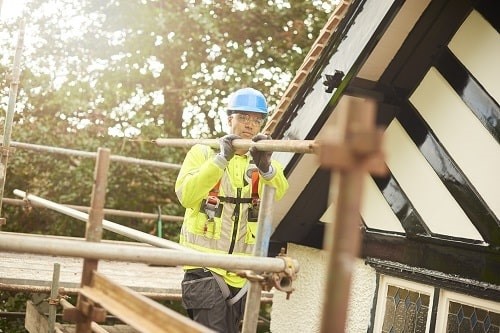Scaffolding has for too long been considered by some to be a high risk, low skill trade. This could not be further from the truth.
Features
More to scaffolding than meets the eye
The erection and dismantling of scaffolding are undoubtedly safety-critical tasks, however contractors recognise this and take the relevant steps to adhere to legislation, industry best practice and guidance and to qualify their operatives via the Construction Industry Scaffolders Record Scheme (CISRS) to mitigate risk.
This has led to a decades-long trend of increasing on-site scaffolding safety standards and a directly proportionate decline in the number of accidents and incidents recorded.
The National Access & Scaffolding Confederation (NASC) is eager to learn from accidents and incidents and openly publish their statistics. The most recent annual Safety Report shows NASC members recorded 113 accidents and injuries on site during 2018.
 The National Access & Scaffolding Confederation (NASC) is eager to learn from accidents and incidents and openly publish their statistics
The National Access & Scaffolding Confederation (NASC) is eager to learn from accidents and incidents and openly publish their statistics
The 113 injuries recorded means that more than 99 per cent of all NASC member operatives – a total of 16,645 employees – went through 2018 accident and injury-free. There were also no operative fatalities for the sixth consecutive year.
No other trade invites more scrutiny from third parties such as clients, site agents, engineers and the Health & Safety Executive than scaffolding; however, the sector does not seem to get the credit it deserves.
In the last 40 years, the sector has taken on the responsibility for greatly improving safe working practices, technical guidance, operative competency and regulation of its contractors, manufacturers and other associated companies.
The NASC produces over 70 guidance notes providing pertinent up-to-date safety, technical, contractual and product purchasing information on a broad range of topics, not only to its members but to all within the scaffolding fraternity and the industry in general.
The NASC committees and working parties who produce these documents are made up of representatives from 100+ member companies, including SMEs as well as very large contractors, manufacturers, training providers, designers, HSE, plus third-party co-opted industry experts.
Top training
The industry has a positive and proactive attitude when it comes to qualifying its workforce, enrolling around 400 – 500 apprentices annually for the last 20 years.
The standard CISRS training programmes also continue to thrive. 1,910 new entrant labourers, 2973 trainee scaffolders, 1,699 scaffolders, and 529 advanced scaffolders registered and qualified with CISRS between January and November 2019.
The scheme is based on off-site training at accredited providers, on-site experience, S/NVQ, health and safety testing and a skills test. It will take around 20 - 36 months to become a scaffolder; all elements must be completed satisfactorily prior to a scaffolder card being issued.
The process is robust and despite some claiming otherwise, people do fail courses. When this is the case, they are required to go back into industry, get more experience, then repeat and satisfactorily complete the programme.
All CISRS programmes are regularly reviewed and standardised to ensure they reflect current practice and that providers pass on the relevant information to delegates via the 41 accredited centres around the UK.
Sector training has come a long way in the last 40 years from Grandfather Rights and industry accreditation, via formal off-site training Part 1, Part 2 etc. (1979), requirement to complete S/NVQ Access and Rigging (1995), first affiliate scheme approached by CSCS (1999) Health Safety Testing and card renewal (2000), New entrant Labourer card (2003), removal of Assessed Route of Entry (1996-2006), Systems Scaffold Training (2006), Scaffold Inspection (2007), and Supervisory training (2007).
One of the most recent additions in 2017 was the CPD and refresher training requirement which must be completed every five years prior to card renewal.
As with all walks of life, there is room for improvement within the scaffolding sector, but the industry is not afraid to tackle any issues it encounters, usually finding a solution from those within its own sector and then rolling it out to wider industry.
It has made great strides in recent years. It is a safe, regulated and qualified trade and can provide a lucrative and very varied career.
For more information: www.nasc.org.uk
FEATURES

Sedentary working and how to combat the ‘sitting disease’
By Gavin Bradley, Active Working on 05 April 2024
Prolonged and excessive sitting poses a major risk to our health, but the Get Britain Standing campaign and On Your Feet Britain Day on 25 April are a great way of encouraging workers to sit less and move more.

Company culture and wellbeing: a crucial link
By Bex Moorhouse, Invigorate Spaces on 05 April 2024
Investing in measures to support worker wellbeing will be ineffective unless the company culture genuinely incorporates values like teamwork, involvement, flexibility and innovation.

Office design and culture: happier and healthier staff – or the opposite?
By Guy Osmond, Osmond Ergonomics on 03 April 2024
Applying ergonomic principles to workstation set-ups and ensuring the physical environment supports neurodivergent people are just some of the ways of creating an office where everyone can thrive, but a supportive and positive organisational culture is vital too.


